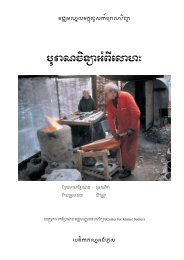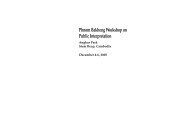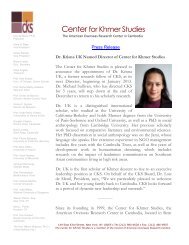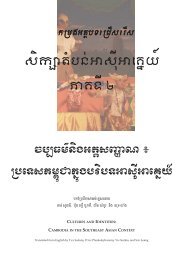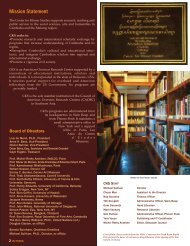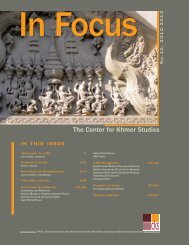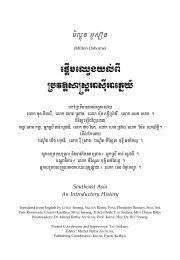Mission Statement - Center for Khmer Studies
Mission Statement - Center for Khmer Studies
Mission Statement - Center for Khmer Studies
You also want an ePaper? Increase the reach of your titles
YUMPU automatically turns print PDFs into web optimized ePapers that Google loves.
The worst village crisis would arise from improper elephant<br />
mating. Details vary, but first, the wedding of the pregnant<br />
cow is required, and involves costly sacrifices of cattle, pigs,<br />
and chickens and the consumption of lots of rice wine. Then,<br />
the cow and her calf must be sold to an elephant owner in a<br />
distant village. Failing these requirements, major illnesses<br />
will descend on the village, and especially on elephant owners.<br />
The focus of the pregnancy is less the expensive wedding<br />
than the dangers resulting from transgressing spiritual<br />
mores.<br />
I was told that breeding would incur devastating health problems<br />
<strong>for</strong> the Bunong people. One owner of an elephant that<br />
had become pregnant in a far-off village contended that now<br />
that she was no longer a virgin, she could be bred. He would<br />
keep the resulting calf. Others sternly disagreed. I suggested<br />
it might be acceptable to breed non-Bunong owned elephants,<br />
say from Rattana Kiri. At this point, the conversation became<br />
so stressful that the hosts being interviewed asked that we no<br />
longer discuss the topic. Bunong recognize the conundrum,<br />
but like most people do not easily yield on their most fundamental<br />
beliefs.<br />
A further anthropological dilemma I struggle to understand is<br />
why so many Bunong treat their elephants badly. Many are<br />
heavily overworked, are worked with debilitating medical<br />
problems, inadequately watered and fed, and harshly handled<br />
by gangs of inexperienced mahouts. I myself come from<br />
a background where great care is taken of one’s working livestock.<br />
I expected that an elephant keeping people would<br />
maintain their valuable charges in top shape. One mistaken<br />
belief is that if an elephant is not working, it does not need to<br />
drink or eat. An elephant requires something in the order of<br />
100 liters of water a day plus many kilos of fodder. In Mondul<br />
Kiri, one sees some elephants in beautiful condition and others<br />
dehydrated and underweight. Many are <strong>for</strong>ced to carry<br />
excessive weight.<br />
One theory holds that their tradition is elephant capture, not<br />
elephant husbandry. The distant ancestors of the Bunong<br />
were provisioners of the royal courts of the region. Once elephants<br />
were caught and broken (tamed), they were sold to<br />
others. To a people who live in scattered villages with low<br />
population density, elephants in number may have been<br />
impractical. Moreover, in parts of old Mondul Kiri, Bunong<br />
were well known as cattle herders, not elephant keepers.<br />
Then, as now, elephants could carry people from village to<br />
village, pack rice and other agricultural goods from fields to<br />
settlements, and haul logs <strong>for</strong> house construction.<br />
The mortality rate of elephants has always been high. Be<strong>for</strong>e<br />
the mid-twentieth century, Bunong simply went to the <strong>for</strong>est<br />
and caught replacements <strong>for</strong> lost stock. By 2009, most village<br />
elephants are aging. Few are under thirty years of age. Some<br />
cows are still coming into heat and could bear young. Mating<br />
of village cows and wild bulls may no longer be an option, but<br />
Bunong reject breeding. Young men suggest they would<br />
attempt to catch wild elephants were the government to<br />
lift the ban on capture. They worry about the loss of elephants<br />
in their culture, but would proceed without full<br />
knowledge of capture ritual.<br />
Elephant husbandry ethnography also focuses on how<br />
elephants are used today. Elephants are less useful than<br />
only a few years ago. Logging is widely illegal. Why<br />
ride a slow elephant to town when a motorcycle will get<br />
you there faster, cheaper, and in style? Why load up an<br />
elephant that needs lots of food and water, when an old<br />
truck will haul more, farther and faster? And, with<br />
resin producing trees being cut by <strong>Khmer</strong>, what resin<br />
will an elephant haul to a middleman? What are elephants<br />
good <strong>for</strong> now? For providing tourists with<br />
rides, of course.<br />
Since my first visit to Mondul Kiri, tourists have<br />
reached all but the most remote villages, and many<br />
come to ride elephants. At one end of the scale is Jack<br />
Highwood’s Elephant Valley Project, where he rehabilitates<br />
abused elephants using funds gained by providing<br />
sophisticated elephant experiences <strong>for</strong> visitors. At<br />
the other end are hotel operators who take tourists to<br />
Bunong villages <strong>for</strong> hourly or overnight trips in howdahs.<br />
Elephants still do pack in rice harvests, work long<br />
hours in the <strong>for</strong>est during resin collection season, and<br />
haul in small timber <strong>for</strong> house construction (Bunong<br />
deny logging, which is illegal). As these tasks diminish<br />
in importance, and as income from tourism rises,<br />
Bunong owned elephants will be assigned to visitors.<br />
Their care and well-being will probably be enhanced.<br />
My research project is far from finished. To understand<br />
elephant keeping people, I must understand elephants.<br />
Since elephants “know” either <strong>Khmer</strong> or Bunong, I<br />
must improve in both languages. As any anthropologist<br />
will concede, to dig deeply into spiritual and social<br />
worlds, one must master language. Working with elephants<br />
is a great way to begin. Happy Lucky’s temper<br />
aside, elephants are intelligent, personable, irascible,<br />
ornery, are sweetie pies and killers, and are, as the<br />
Bunong know, “like people.” I expect to spend many<br />
years ahead hanging out with these beauties.<br />
p.s. Happy Lucky is so called because when she arrived<br />
at the Elephant Valley Project she was a nervous wreck,<br />
was in ill health, and faced a grim future. After intensive<br />
care, she is both happy and lucky.<br />
Professor Bion Griffin is a CKS Board Member<br />
16 IN FOCUS




